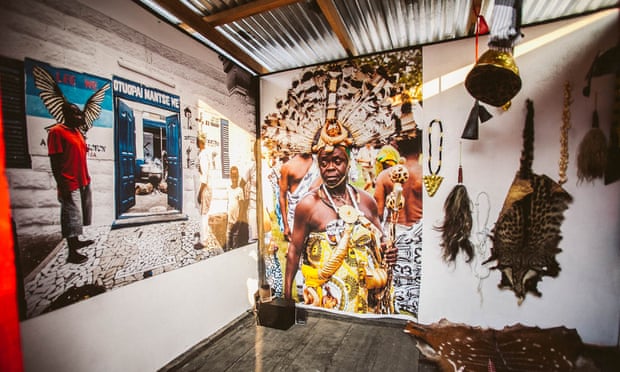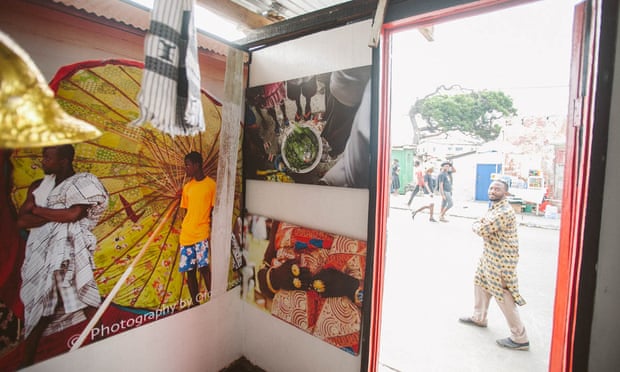Ghana's First Travelling Museum Ready To Tour The 10 Regions
An
innovative project in Ghana aims to make movable museums available nationwide
by taking a small kiosk-sized gallery on the road to showcase artworks and
cultural artifacts.
 The “kiosk
museum” is the brainchild of Nana Oforiatta Ayim, a writer and film-maker, and
founder of ANO, a non-profit art space in Accra. She decided to make use of an
ubiquitous feature of west African architecture: the semi-legal containers
present on every street corner, usually used by mechanics, hairdressers or
stores selling food and supplies.
The “kiosk
museum” is the brainchild of Nana Oforiatta Ayim, a writer and film-maker, and
founder of ANO, a non-profit art space in Accra. She decided to make use of an
ubiquitous feature of west African architecture: the semi-legal containers
present on every street corner, usually used by mechanics, hairdressers or
stores selling food and supplies.
Ayim
collaborated with DK Osseo-Asare, an architect who has spent more than a decade
researching kiosk culture and designing units in Ghana and Nigeria. He said
official government policy was to “excise the informal from the city”,
referring to the state’s disdain for the semi-legal structures, which have been
flattened and torn down in some areas.
Latifah
Idriss, an Accra based architect who has worked with Ayim to further develop
the structures, said kiosks were “not considered as proper” by the government
because “in a country that lacks welfare, they manifest as the architecture of
poverty”.
Ayim’s project
celebrates the informal structures. In December, the curator will begin a
mammoth journey with the kiosk, starting in the capital, Accra, and travelling
across Ghana’s 10 regions.
''The majority
of Ghanaians get their bread and milk from kiosks, so nobody gets intimidated
about entering them'' - Nana Nyarko
Boateng
Ayim said
she started to reflect on the museum model in Africa while working at the
British Museum. Struck by how differently African objects were encountered in
display cabinets in the UK with how they were actively used in festivals back
home, she began to think about how material culture could be preserved and
presented in a way that was more in keeping with local traditions.
The “white
cube” gallery, an idea developed in the west, doesn’t make sense in Ghana, she
said, where art plays a different role in society. “I think it’s important to
ask at every stage, how suitable is this model for the context we inhabit?
Especially ''as we are'' coming out of the post colonial moment a moment in which
we were defining ourselves largely based on a western model.”
Nana Nyarko
Boateng, who visited the kiosk museum at Chale Wote street art festival this
year, said she thought using something so familiar “as a tool for learning and
engendering discussions about ourselves is just brilliant and absolutely
pertinent”.
“The
majority of Ghanaians get their bread and milk and sugar from kiosks, so nobody
gets intimidated about entering them,” she said.
Ayim said
with each new location the exhibition inside the kiosk changes. “Film and
photographs, documents, old letters we ask people to bring things in and then
we display them in the kiosk museum to document, and for '' other '' people to
interact with,” she explained.
 During the
Chale Wote festival in Jamestown, the kiosk museum presented photographs by
Ofoe Amegavie alongside other artifacts. Visitors were encouraged to interact
with the objects and share their stories. With its doors open to the street,
the small booth only two meters by three meters (8ft by 10ft) welcomed
thousands of visitors.
During the
Chale Wote festival in Jamestown, the kiosk museum presented photographs by
Ofoe Amegavie alongside other artifacts. Visitors were encouraged to interact
with the objects and share their stories. With its doors open to the street,
the small booth only two meters by three meters (8ft by 10ft) welcomed
thousands of visitors.
It’s early
days for the kiosk museum, as Ayim and her team figure out how to make the
infrastructure sustainable. “Can we create an alternative based on a different
value system, a different way of growing. I think we can, and that’s exciting,”
Ayim said.
Source; theguardian
Source; theguardian




Comments
Post a Comment